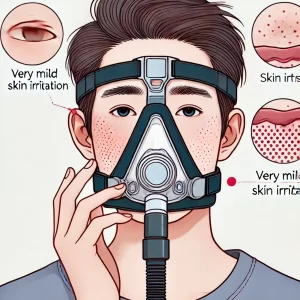CPAP Dermatitis: Whats the Treatment?
Jeremy Smith is a long-term CPAP user and sleep apnea advocate. After being diagnosed with severe obstructive sleep apnea, he created ByJeremySmith.com to help others navigate CPAP therapy through personal stories, gear reviews, and practical advice.
CPAP dermatitis is probably something that is giving you grief if you have found your way to my blog.
I have been using my CPAP machine for over 10 years now and I have had no issues, but clearly, it is a problem that people encounter.

Dermatitis caused by CPAP use can range from mild irritation to more severe reactions that impact sleep quality and compliance with therapy.
In this article, we’ll explore the connection between CPAP machines and dermatitis, why it occurs, and what you can do to prevent or treat it.
What Is Dermatitis?
Dermatitis refers to inflammation of the skin that results in symptoms such as redness, itching, and swelling. There are different types of dermatitis, including contact dermatitis (caused by skin contact with an irritant or allergen), atopic dermatitis (often related to allergies or asthma), and seborrheic dermatitis (caused by excessive oil production).
When it comes to CPAP use, contact dermatitis is the most common form, typically caused by prolonged contact with the CPAP mask or headgear. Other factors like trapped moisture, pressure from the mask, and skin sensitivity can also contribute to the development of dermatitis.
How Does a CPAP Machine Cause Dermatitis?
The CPAP mask and headgear must fit snugly to prevent air leaks during therapy, but this constant contact with the skin can lead to irritation. Here are the main ways that CPAP use can contribute to dermatitis:
1. Mask Pressure
CPAP masks press against the skin to create a seal, especially in areas like the bridge of the nose, cheeks, and around the mouth. This pressure can cause friction and irritation, especially if the mask is too tight or poorly fitted. Over time, this pressure can result in redness, soreness, and even the breakdown of the skin barrier, leading to contact dermatitis.
2. Allergic Reactions
Some individuals may be sensitive or allergic to the materials used in CPAP masks, such as silicone, rubber, or latex. An allergic reaction to these materials can result in redness, itching, and swelling where the mask touches the skin. This is known as allergic contact dermatitis, and it can worsen if not addressed.
3. Moisture and Sweat
CPAP masks trap moisture and sweat, particularly in areas where the mask touches the face. This moisture can create an environment where bacteria or fungi thrive, leading to skin irritation and rashes. Excessive moisture, combined with pressure from the mask, can also cause maceration, where the skin becomes soft and more prone to damage.
4. Skin Sensitivity
Some CPAP users may have pre-existing skin conditions such as rosacea or eczema, making their skin more susceptible to irritation. The pressure and material of the mask, combined with any pre-existing sensitivity, can exacerbate these conditions, leading to flare-ups of dermatitis.
Symptoms of CPAP-Related Dermatitis
The symptoms of dermatitis caused by CPAP use can vary from mild to severe, depending on the individual’s skin type, mask fit, and other factors. Common symptoms include:
- Redness or rash where the mask touches the face.
- Itching or burning sensations in affected areas.
- Dry or flaky skin around the nose, cheeks, or chin.
- Swelling or puffiness in areas of contact with the mask.
- Sores or blisters in severe cases of prolonged irritation.
These symptoms can affect your comfort and willingness to continue using the CPAP machine, so it’s important to address any skin irritation as soon as possible.
Preventing Dermatitis While Using a CPAP Machine
Fortunately, there are several steps you can take to prevent or minimize dermatitis related to CPAP use. Here’s what you can do to protect your skin while maintaining effective CPAP therapy:
1. Choose the Right Mask
Choosing a mask that fits well without excessive pressure is key to preventing skin irritation. Consider trying different mask types—such as nasal masks, nasal pillows, or full-face masks—to find one that is comfortable and fits securely without causing friction. Some CPAP masks are designed with softer materials or cushioning to reduce skin contact and minimize irritation.
2. Use CPAP Mask Liners
CPAP mask liners can act as a barrier between your skin and the mask, reducing friction and preventing moisture buildup. These liners are typically made from soft, breathable materials like cotton or fleece and can help wick away moisture while reducing the chances of irritation.
3. Clean Your Mask Regularly
Regularly cleaning your CPAP mask and headgear can help remove dirt, oils, and bacteria that may contribute to skin irritation. Use gentle, non-irritating soap and warm water to clean the mask daily, and ensure it is completely dry before use. Avoid using harsh chemicals that may leave residues on the mask and trigger allergic reactions.
4. Adjust Your Mask Fit
Ensuring that your mask is properly adjusted can prevent excessive pressure and friction on the skin. A mask that is too tight can cause irritation, while a mask that is too loose can lead to air leaks and further discomfort. Work with your CPAP provider to find the right fit and regularly check the straps for wear or overstretching.
5. Moisturize Your Skin
Applying a gentle, fragrance-free moisturizer to your skin before bed can help strengthen the skin barrier and prevent dryness. However, avoid using oils or greasy creams, as these can interfere with the mask’s seal and lead to further irritation.
Treating CPAP-Related Dermatitis
If you’re already experiencing dermatitis from CPAP use, there are steps you can take to treat the irritation and get relief:
1. Topical Corticosteroids
Over-the-counter or prescription-strength corticosteroid creams can help reduce inflammation and soothe irritated skin. Apply a small amount to affected areas, but consult your doctor before using them regularly, as overuse can thin the skin.
2. Antihistamines
If your dermatitis is caused by an allergic reaction to your mask’s material, oral or topical antihistamines may help reduce itching and swelling. Talk to your doctor about the best options if you suspect an allergic reaction.
3. Switch to Hypoallergenic Masks
If you’re experiencing an allergic reaction to your CPAP mask, switching to a hypoallergenic CPAP mask made from alternative materials may alleviate your symptoms. Some masks are made from materials specifically designed for sensitive skin, such as silicone-free options.
4. Use Hydrocolloid Dressings
For severe irritation, hydrocolloid dressings can be applied to the skin under the mask to provide a protective barrier and promote healing. These dressings are often used for pressure sores and can help reduce the impact of mask pressure on irritated skin.
Conclusion: Managing Dermatitis While Using a CPAP Machine
Using a CPAP machine is essential for treating obstructive sleep apnea, but skin irritation and dermatitis can make it difficult to continue therapy.
By taking preventative steps, such as choosing the right mask, using mask liners, and keeping your mask clean, you can reduce the risk of developing dermatitis.
If you do experience skin irritation, there are several treatment options available to alleviate symptoms and keep you on track with your CPAP therapy.
Let me know if you have had any issues with your CPAP Machine and Dermatitis. Maybe you have some tips to share with other readers.
Disclaimer: The content on this blog is for informational and educational purposes only and is not a substitute for professional medical advice. Always speak with your doctor or sleep specialist before starting, stopping, or changing any treatment or therapy related to sleep apnea or CPAP use.





